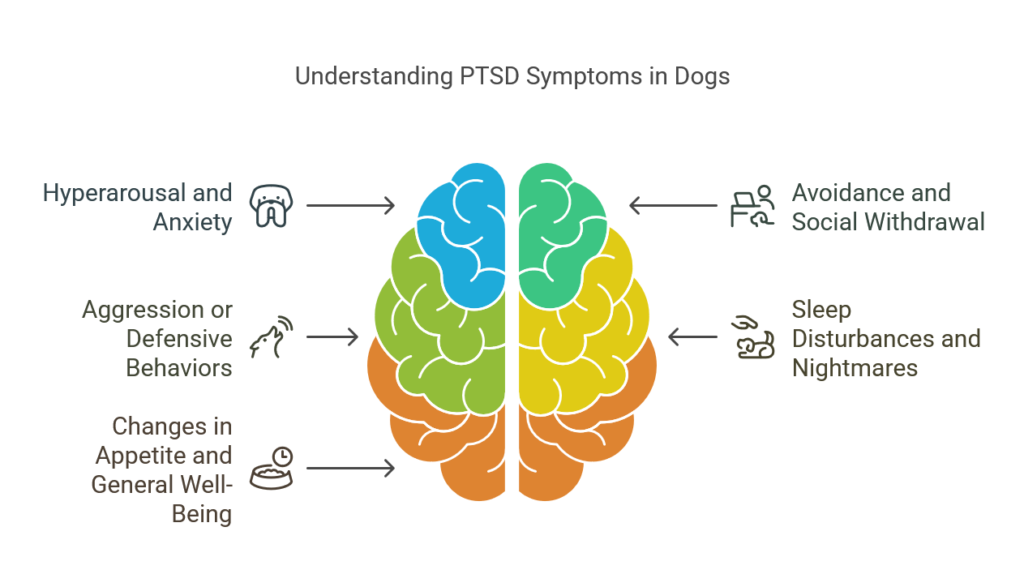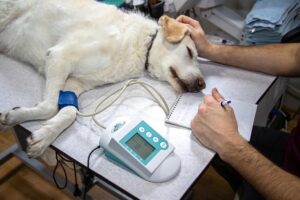Table of Contents
1. Introduction: Can Dogs Get PTSD?
Post-Traumatic Stress Disorder (PTSD) is not exclusive to humans—it can profoundly affect dogs as well. Dogs who have experienced severe trauma, such as abuse, abandonment, or exposure to extreme stress, may develop PTSD-like symptoms that impact their behavior, emotional stability, and overall well-being. While dog PTSD is not as widely discussed as it is in humans, growing research highlights its existence and the challenges it presents for pet owners, trainers, and veterinarians alike.
Many dog owners are familiar with common anxieties in their pets, such as fear of fireworks or hesitation around strangers. However, dog PTSD goes beyond general fear; it involves a deep-seated emotional response that can manifest in severe avoidance, hyperarousal, aggression, and a diminished quality of life. Understanding the root causes, symptoms, and biological mechanisms behind this condition is essential for providing the right treatment and helping affected dogs regain confidence and emotional balance.
Recent studies have reinforced the importance of structured interventions, including behavioral therapy and animal-assisted treatments, to support dog PTSD (Frontiers in Psychology, 2020). This article provides a comprehensive overview of PTSD in dogs, including its symptoms, causes, scientific underpinnings, and the expected recovery timeline for affected animals.
2. Understanding Dog PTSD
2.1 What Causes Dog PTSD?
Dog PTSD can arise from various traumatic experiences, many of which leave lasting psychological scars. Some of the most common triggers include:
- Abuse and Neglect – Dogs that have been physically harmed, deprived of basic needs, or confined in stressful environments (such as puppy mills) are at higher risk.
- Separation Trauma and Abandonment – Rescue dogs that have been rehomed multiple times or abandoned often develop chronic anxiety that can progress to PTSD.
- Natural Disasters and Accidents – Surviving earthquakes, floods, fires, or severe car accidents can cause a dog to develop long-term trauma responses.
- Military or Police Work – Working dogs, particularly those in law enforcement or the military, may experience combat stress or trauma from high-risk operations (JAMA Network, 2024).
- Severe Medical Procedures – Painful surgeries, prolonged hospitalization, or repeated exposure to distressing medical experiences may lead to PTSD-like behaviors.
2.2 Symptoms of Dog PTSD
The signs of Dog PTSD can vary in severity and presentation, but common behavioral changes include:
- Hyperarousal and Anxiety
- Excessive panting, restlessness, or pacing
- Heightened startle response to loud noises or sudden movements
- Dilated pupils and trembling even in non-threatening environments
- Avoidance and Social Withdrawal
- Reluctance to enter specific rooms or places associated with trauma
- Avoiding eye contact or interaction with people and other dogs
- Loss of interest in play or favorite activities
- Aggression or Defensive Behaviors
- Uncharacteristic growling, snapping, or lunging at people or animals
- Defensive posturing even in familiar environments
- Overprotective behaviors toward their owner
- Sleep Disturbances and Nightmares
- Whimpering, twitching, or sudden movements while sleeping
- Difficulty settling down for rest
- Sudden waking up in distress
- Changes in Appetite and General Well-Being
- Loss of appetite or excessive eating as a coping mechanism
- Gastrointestinal issues linked to chronic stress (Frontiers in Psychology, 2018)

How to Differentiate PTSD from General Anxiety
While some symptoms of dog PTSD overlap with general anxiety, PTSD is more deeply rooted in past trauma and often results in severe, persistent behavioral changes. Unlike typical anxiety, which may fluctuate based on immediate triggers, PTSD-related symptoms often appear disproportionate to the situation and persist even in the absence of direct stimuli.
A veterinarian or a certified canine behaviorist can assess whether a dog’s behaviors are due to PTSD, generalized anxiety disorder, or another underlying health issue. Diagnostic approaches may include behavioral evaluations and physiological assessments of stress hormone levels (Plos One, 2022).
3. The Science Behind Dog PTSD
3.1 How Trauma Affects the Canine Brain
PTSD in dogs, much like in humans, is believed to be linked to dysregulation in the brain’s stress-response system. The hypothalamic-pituitary-adrenal (HPA) axis, which regulates stress hormones such as cortisol, plays a crucial role in how dogs process traumatic experiences. When a dog undergoes extreme stress, the HPA axis can become overactive, leading to prolonged fear responses and difficulty returning to a relaxed state.
Key physiological changes observed in traumatized dogs include:
- Elevated Cortisol Levels – Dogs with PTSD often show prolonged stress responses due to persistent cortisol elevation (PMC, 2020).
- Altered Amygdala Function – The amygdala, which processes fear and emotional responses, becomes hypersensitive, causing exaggerated reactions to minor triggers.
- Impaired Hippocampus Activity – The hippocampus, responsible for distinguishing between safe and threatening environments, may shrink or function improperly, leading to generalized fear and avoidance behaviors.
Understanding these neurological mechanisms can help guide treatment approaches that focus on retraining the brain’s stress responses through structured behavioral therapy and environmental modifications.
3.2 Key Comparisons: PTSD in Dogs vs. Humans
Although PTSD in dogs shares many characteristics with PTSD in humans, there are notable differences in how symptoms present and how treatment is approached.
| Feature | Dogs | Humans |
| Symptoms | Anxiety, avoidance, aggression | Flashbacks, nightmares, avoidance |
| Triggers | Loud noises, specific places, sudden movement | Reminders of trauma, stressful situations |
| Treatment | Training, behavior therapy, AAI | Therapy, medication, coping skills |
| Recovery Time | Weeks to months (varies) | Months to years (individualized) |
Recent research suggests that PTSD in dogs is best managed through a combination of positive reinforcement training, counterconditioning, and environmental support to gradually desensitize them to traumatic memories (PMC, 2021).
4. The Recovery Timeline: What to Expect
Recovering from PTSD in dogs is a gradual process that depends on the severity of trauma, the dog’s temperament, and the consistency of rehabilitation efforts. While some dogs show improvement in weeks, others may take months or even years to fully regain confidence and emotional stability. Below is a general timeline outlining the key phases of recovery.
4.1 Phase 1: Recognition & Early Intervention (Weeks 1–4)
The first step in helping a dog recover from PTSD is recognizing the signs and implementing immediate interventions. During this phase, the primary goal is to reduce stress and establish a safe environment for the dog.
Key Steps:
- Identify Triggers – Observe behavioral responses to certain sounds, environments, or people.
- Create a Safe Space – Provide a designated area where the dog feels secure (a quiet room, crate with soft bedding, or a secluded corner).
- Establish Routine & Predictability – Consistent feeding times, regular walks, and structured play help reduce anxiety.
- Limit Exposure to Triggers – Avoid stressful situations while the dog adapts to a controlled, calm environment.
🐾 Pro Tip: Avoid forcing interactions with people or other animals during this stage. Pushing too soon can reinforce fear responses rather than reduce them (Frontiers in Psychology, 2020).
4.2 Phase 2: Training & Rehabilitation (Months 1–3)
Once the dog feels more secure, structured training can begin. This phase focuses on behavior modification and emotional desensitization to trauma-related triggers.
Key Techniques:
- Desensitization Training – Gradually exposing the dog to mild versions of their triggers (e.g., playing a quiet thunderstorm recording at a low volume before slowly increasing it).
- Counterconditioning – Pairing triggers with positive experiences (e.g., giving treats when a feared sound plays).
- Environmental Adaptations – Using pheromone diffusers (e.g., Adaptil) and calming supplements to ease stress (Plos One, 2022).
Some owners may see significant improvement in this stage, while others may need additional behavioral therapy, especially for dogs with severe PTSD symptoms.
4.3 Phase 3: Long-Term Management & Emotional Healing (3+ Months)
As training progresses, the final phase focuses on reinforcing positive behaviors and ensuring the dog continues to build confidence in different environments.
Key Focus Areas:
- Animal-Assisted Interventions (AAI) – Some dogs benefit from structured programs that pair them with therapy animals or trained service dogs for emotional support (PMC, 2021).
- Consistent Reinforcement – Maintaining positive training techniques even after improvements are seen.
- Monitoring for Regression – Tracking behavioral changes to prevent setbacks.
🐾 Key Takeaway: Recovery is not always linear—setbacks may occur, but with patience and consistency, most dogs can regain their sense of security and trust.

5. Treatment & Recovery Approaches
5.1 Behavioral Therapy & Professional Training
Professional intervention from a veterinary behaviorist or certified dog trainer is often necessary for dogs with severe PTSD. Common approaches include:
- Positive Reinforcement Training – Encouraging calm behaviors with rewards rather than punishment.
- Clicker Training – Teaching dogs to associate positive behaviors with clicker sounds and treats.
- Gradual Exposure Therapy – Systematic desensitization to fearful stimuli in a controlled setting.
🔍 Case Study: A study on PTSD service dogs found that structured training programs significantly improved emotional regulation and socialization skills in affected dogs (JAMA Network, 2024).
5.2 The Role of Medication
For extreme cases, medication may be recommended to help regulate a dog’s anxiety and emotional responses.
💊 Commonly Prescribed Medications:
- Fluoxetine (Prozac) – An SSRI that helps manage chronic anxiety.
- Trazodone – A sedative often prescribed for dogs with severe situational anxiety.
- Clonidine or Prazosin – Medications used for phobia-related stress, particularly in cases of night terrors and hyperarousal (PubMed, 2023).
🐾 Important Note: Medications should always be paired with behavioral interventions—they are not a cure but a supportive tool.
5.3 Alternative Therapies
For owners who prefer non-pharmaceutical interventions, there are alternative therapies that may complement traditional treatments.
✅ Animal-Assisted Therapy (AAT) – Studies suggest that therapy dogs can significantly reduce PTSD symptoms in both humans and dogs, creating a calming presence that promotes recovery (Frontiers in Psychology, 2018).
✅ CBD & Calming Supplements – Some owners report success using CBD oil, L-theanine, and melatonin to reduce anxiety, though research is still ongoing regarding efficacy.
✅ Acupuncture & Massage Therapy – Can help relax hyperaroused nervous systems and improve stress resilience in dogs with PTSD.
🐾 Best Practice: Always consult a veterinarian before introducing supplements or alternative therapies to ensure they are safe for your dog.
6. Challenges, Controversies & Emerging Trends
6.1 Controversies in PTSD Treatment for Dogs
- Lack of Standardized Protocols – Unlike human PTSD treatments, canine PTSD treatments vary widely between trainers, veterinarians, and behavioral specialists (PMC, 2020).
- Questionable Training Methods – Some outdated training programs rely on dominance-based techniques that may exacerbate fear and stress rather than alleviate it.
- Service Dog Misuse – The rise in unqualified emotional support animals (ESAs) has sparked debate over training standards and ethical concerns (Plos One, 2022).
6.2 Gaps in PTSD Research for Dogs
While PTSD in dogs is increasingly recognized, there is still a need for more clinical research. Key gaps include:
- Long-term impact of PTSD treatments on canine behavior.
- More extensive studies on the effectiveness of SSRIs and other medications.
- Ethical considerations regarding service dog breeding programs.
🚀 Future Research Directions: Ongoing studies are beginning to explore genetic predisposition to PTSD in dogs, which could pave the way for preventative interventions rather than just reactive treatments.
6.3 Emerging Trends in PTSD Treatment
- AI-Assisted Therapy Tools – Some studies are exploring AI-based emotion tracking software for dogs to monitor stress levels.
- Genetic Testing for PTSD Susceptibility – Researchers are investigating whether some breeds have a genetic predisposition to PTSD-like symptoms.
- Holistic & Integrated Therapies – Combining behavioral therapy, environmental enrichment, and alternative treatments to create multi-layered recovery plans.
Conclusion:
PTSD in dogs is a serious but manageable condition that requires patience, structure, and the right therapeutic approach. Whether caused by past abuse, military service, medical trauma, or a distressing life event, PTSD can significantly impact a dog’s behavior, emotional stability, and overall quality of life.
The good news? With the right combination of behavioral therapy, environmental modifications, and—if needed—medical or alternative interventions, most dogs can recover and lead fulfilling lives. The key is consistency, understanding, and a commitment to helping your dog regain trust and confidence.
💡 Key Takeaways:
✔️ PTSD in dogs is real and scientifically supported—it affects both brain chemistry and behavior.
✔️ Symptoms range from hyperarousal and aggression to avoidance and sleep disturbances.
✔️ Recovery follows a gradual timeline, with initial stress reduction, structured training, and long-term reinforcement.
✔️ Professional guidance (from a behaviorist or veterinarian) is often necessary for severe cases.
✔️ Treatment is holistic—behavioral training, environmental changes, and sometimes medication or alternative therapies work best together.
🔎 Final Thought:
Healing takes time, and there is no one-size-fits-all approach. Some dogs recover quickly, while others may need months or even years to fully heal. The most important thing is providing a safe, patient, and loving environment where your dog can rebuild their confidence and learn that the world isn’t a scary place.
If you suspect your dog is suffering from PTSD, reach out to a veterinarian, certified dog trainer, or animal behaviorist to start their journey toward recovery. 🐕💙
FAQs
Q1: How do I know if my dog has PTSD or just anxiety?
While anxiety and PTSD in dogs share some overlapping symptoms, PTSD tends to be trigger-specific and more deeply ingrained. If your dog displays persistent fear, avoidance, aggression, or hyperarousal even in non-threatening situations, PTSD might be the cause. A professional evaluation from a veterinarian or behaviorist is the best way to confirm a diagnosis.
Q2: Can PTSD in dogs go away on its own?
It is unlikely that PTSD in dogs will resolve without intervention. While some mild cases improve over time, chronic PTSD requires structured training, behavior modification, and environmental support to help the dog recover.
Q3: What breeds are most prone to PTSD?
PTSD can affect any breed, but certain breeds may be more sensitive to trauma due to their genetic makeup or historical roles.
🐶 Commonly affected breeds include:
- German Shepherds & Belgian Malinois – Often used in police/military work, making them susceptible to combat stress.
- Labrador Retrievers & Golden Retrievers – Frequently used as service dogs, some may experience secondary trauma.
- Border Collies & Australian Shepherds – Highly intelligent and sensitive, they can develop PTSD-like responses if neglected or abused.
However, any dog, regardless of breed, can develop PTSD following severe trauma.
Q4: Are there medications for PTSD in dogs?
Yes. Veterinarians may prescribe SSRIs like fluoxetine (Prozac) or trazodone to help regulate stress responses in extreme cases. However, medication is most effective when combined with behavioral therapy and structured training.
Q5: Can PTSD in dogs be cured completely?
Some dogs fully recover, while others may always retain some level of sensitivity to triggers. However, with the right interventions, most dogs can lead happy, well-adjusted lives. The goal of treatment is to reduce fear responses and help the dog feel safe in daily life.
Q6: How can I help a rescue dog with PTSD?
If you’ve adopted a rescue dog showing signs of PTSD, follow these steps:
✔️ Give them time and space to adjust to their new environment.
✔️ Build a predictable routine to provide stability.
✔️ Avoid forcing interactions—let them come to you at their own pace.
✔️ Use positive reinforcement training to build trust.
✔️ Consult a professional if symptoms persist or worsen.
💡 Rescue dogs can thrive with patience and love! 🐕💕
Q7: Do service dogs get PTSD?
Yes. Military and police service dogs are at high risk of developing PTSD due to exposure to loud explosions, combat stress, and high-risk situations. Studies show that retired service dogs often require rehabilitation and specialized care to help them transition to civilian life (JAMA Network, 2024).




